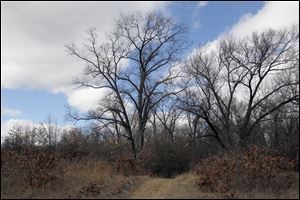
Wildwood Preserve restoration work starts
Goal is to remove non-native plants in 3-year project
2/19/2013
Wildwood Preserve Metropark will undergo intensive restoration work that will result in improved habitat for numerous species, including birds, more than 50 types of butterflies, and many types of rare, native plants.
It may be the dead of winter, but crews with the Metroparks of the Toledo Area plan to begin mowing at Wildwood Preserve Metropark this week.
Their task: To remove woody invasive plants from natural prairie areas of the Sylvania Township preserve. It’s the first step in a three-year, $500,000 prairie restoration effort that aims to improve the habitat for rare, native plants and native species, including birds and butterflies.
“Wildwood is part of the Oak Openings region, which has one of the largest concentrations of rare plant and animal species in the state of Ohio,” said Tim Schetter, director of natural resources for Metroparks. “This will improve native biodiversity at Wildwood, and from a visitor standpoint these areas, once restored, are going to look pretty impressive with displays of native wildflowers and prairie grasses. To visitors, it will be much more attractive than what it is now.”
Existing vegetation will be cut to the ground this winter. Then, in the spring, herbicides will be used to weed out non-native species.
“When [non-native plants] invade the prairie, they block light from reaching the prairie plants and it chokes them out over time,” Mr. Schetter explained.
The project, including staff time, equipment, fuel, and supplies, is being paid for with a $503,176 grant awarded to Metroparks through Partners for Clean Streams.
The nonprofit had received $800,176 from the National Oceanic and Atmospheric Administration as part of the Great Lakes Restoration Initiative.
Metroparks hired five employees to do the work, and 13 seasonal workers are to be added this summer to help as well, Mr. Schetter said.
While the mowed areas will look radically different than the overgrown fields park visitors are used to seeing, Metroparks spokesman Scott Carpenter said signs will be posted and fact sheets made available to explain the project.
After a year or two, visitors will begin to see the transformation.
Mr. Schetter said Metroparks crews will plant native wildflowers and grasses in the cleared areas, using species propagated in the Metroparks’ Blue Creek Native Seed Nursery.
The project is expected to benefit sun-loving plants and attract approximately 50 species of butterflies and a variety of birds.
Reptiles and amphibians, bats, and other mammals will benefit from the habitat improvements.
Mr. Carpenter said the mowing is scheduled to be done at night. It is to begin in an area visible from the Yellow Trail that’s known as Susan’s Meadow.
The area is home to the large oak tree that is featured in the Metroparks’ logo.
The other areas to be restored include the Orange Trail Prairie, which can be seen from the All Purpose Trail, and the Purple Trail Prairie, which is also known as the Stranahan Meadow.
Mr. Schetter estimated that less than 10 percent of Wildwood’s 493 acres is actually prairie.
Contact Jennifer Feehan at jfeehan@theblade.com or 419-213-2134.